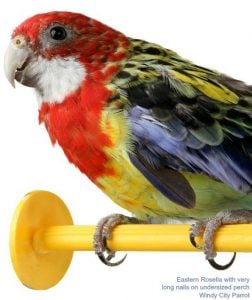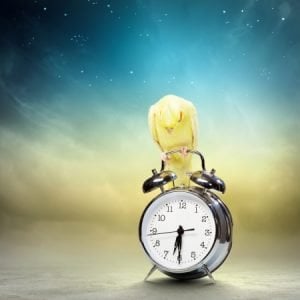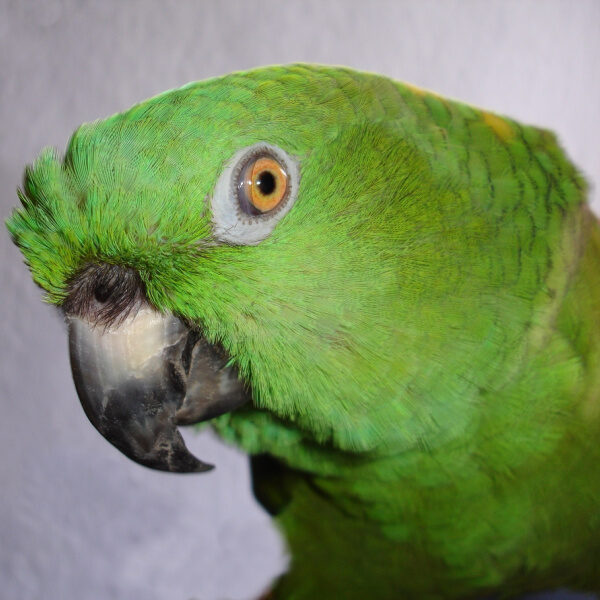
How This Blind Couple Handles 4 Parrots
Last Updated on by Catherine Tobsing
Debra C. writes:
I enjoyed the article entitled “Should Blind People Own Pet Birds“.
My husband and I are both totally blind.
I am 62 and Barry my husband is 67.
I have kept birds most of my adult life since I was in my early 20s.
I have never had a really large bird the largest being my precious male blue-headed Pionus, Andy.
I also have 3 budgies, Jade, Turquoise, and Lavender.
Lavender is the male of the 3 budgies.
I had to smile at some of the questions you had.
How will you reach a bird that is on top of its cage out of reach?
The same way a sighted person does.
I have to admit I once had the same kind of questions that you have.
That was before I went totally blind from RP.
From the National EYE Institute:
“RP is a genetic disease that people are born with. Symptoms usually start in childhood, and most people eventually lose most of their sight. There’s no cure for RP. But vision aids and rehabilitation (training) programs can help people with RP make the most of their vision.”
When I was in my mid-30s I went from being able to read with glasses to total blindness in about 1 1/2 years.
It took me about 5 years or so to fully adapt to being blind.
But I am now blown away by just how adaptable the human mind is.
Did you know that about 1/3 of your brain is used for processing vision?
Did you know that the brain of blind people will rewire itself to use that portion of the brain to process other senses?
You wouldn’t think that a person would get used to being blind but It has become such a natural part of who I am I don’t think about it anymore.
A while back I was visiting a friend and she told me there was a pot of freshly brewed coffee in the kitchen and I started to go into the kitchen to pour myself a cup of coffee.
The door to the kitchen is always open but as I reached the door from the living room to the kitchen I automatically reached out for the doorknob to open it.
My friend said how did you know the door was shut?
I actually had to stop and think about that a minute.
I knew the door was shut as soon as I approached it. How did I know?
It took me a few seconds to realize the sound of my footsteps had been very slightly different.
The difference was so slight that no one else would notice but my mind had picked it up and I had not even been conscious of it at the time.
If we blind couples can raise our human children through those toddler years when their little hands and feet are constantly in motion and manage to childproof our homes and then do the same thing for our grandchildren we can manage to take care of our feathered children with no less diligence.
Like I said I just had to smile.
It really is something that you can’t wrap your mind around unless you have been there.
So keep up the interesting and informative articles I am an avid bird lover, they are such unique and beautiful creatures and I love learning as much as I can about them.
Hi Debra
Unfortunately today we seem to be defined by what we are, not who we are.
Handicapped people are defined by their handicaps.
Gay people are defined by their gayness.
I am an American-born Jew and somehow that puts me in a certain category in the minds of many people.
I find it interesting that having gone blind as an adult you at least are able to carry with your mental pictures.
You know what the colors “Jade, Turquoise, and Lavender” look like.
You know what a blue-headed pionus looks like.
Although you say you only had small birds a blue headed pionus weighs in at about 250g the size of a small Timneh African grey.
This Thursday I’m having a consultation about getting cataract surgery.
Studying the human eye is helping me understand and prepare for this new adventure.
Like anything in life, eyesight is something that we take for granted until we lose it.
So we will take this conversation in a new direction.
Let’s talk about how radically different birds’ eyes are from human eyes.
We talk about how birds can see “ultraviolet light”.
Why is it necessary?
It turns out that your three budgies can emit ultraviolet light through their feathers signaling to other birds in the flock their potential quality of a mate, somehow.
Some berries that birds feed on have a UV hue.
European kestrels track prey from UV reflecting off the prey’s own entrails.
The positioning of the eyes in the pet birds we keep means they are usually on the sides of their heads.
This is useful in flight.
Humans have eyes in the front of their head much like owls who have “binocular vision”.
We think we’re pretty slick because we can move our eyes up and down left and right without moving our heads but birds must move their heads because of their fixed eyes.
A real-world example that everyone can relate to is a red-breasted Robin looking for worms.
Their heads are always tilted giving them a better vision of the ground when seeking worms.
The literal flip side is that their other eye is always looking up into the sky but the brilliant little birdie brains split the signals into so that the Robin can focus on the ground where the worms are.
Before going further I’ll share with you that my summer read is The Origin of Species by Charles Darwin which I found on LibriVox.
I can’t help but think how things like social media and multifaceted devices are actually changing our evolution.
These relatively new mediums are affecting our eyesight, how we sit and stand, and our need to learn (we all have Google) clearly lessening our chances of survival.
Bird’s eyes can alter their focus very quickly through something called “accommodation”.
Birds who have been evolving for more than 100 million years have the best eyesight of all vertebrates.
Diurnal birds, those that search for food in the daylight-like parrots have larger eyes.
Birds, in general, have a much higher eye-to-body size ratio than any other animal.
They also get light information to their brains as much as 60% higher in some species like pigeons and chickens.
Some avian species can actually remember over 6,000 images of caches where food is stored.
But Darwin points out there’s always an exception like the Kiwi who is a nocturnal bird who lives in perpetual darkness and is virtually blind while relying on his other senses.
We know that bird’s brains are divided in half and they can even allow one half of the brain to sleep while the other one is awake should predators come close.
Remarkably some birds actually use the right and left eye for different tasks.
The chicks of chickens that laid the eggs that you had for breakfast will approach their parent using their left eye.
Falcons see the prey in a wide arc rather than a straight line but use mostly the right eye to do this.
The bird with the greatest visual acuity that we know of is the Australian wedge-tailed eagle.
Although many birds would benefit from even better vision, eyes are fluid-filled structures making them heavy possibly hindering flight.
In the human eye, three photoreceptors are called cones found in the retina which help define the color of light being absorbed red, green and blue.
Is the same three color channels we use in television and video which one blended together to provide the full visible spectrum of color.
Compared to birds our ability to see color sucks.
Birds have a possible fourth visual pigment which is what we think allows them to see ultraviolet light.
Birds also have oil droplets located in front of the visual-pigment-containing outer segments.
Think of them as high-power spherical microlenses which work well for birds that have carotenoid pigments.
We believe that they help filter colors like the yellow droplets which may be removing blue from the background increasing the contrast between an object (prey) and the big blue sky.
So let’s stop patting ourselves on the back for all the wonderful accomplishments we humans have brought to our troubled planet.
A falcon can see a “mouse at a mile” and can brighten the background “the sky” to better see flying prey.
How are those contact lenses working out for you, you mammal?
Best
MitchR
Author Profile
Latest entries
 The Traveling BirdJune 26, 2025Can You Name 5 Parrot Species That Are Living Wild in the USA?
The Traveling BirdJune 26, 2025Can You Name 5 Parrot Species That Are Living Wild in the USA? Bird BehaviorJune 26, 2025How is it Parrots Are Problem Solvers Social Animals and Even Use Tools?
Bird BehaviorJune 26, 2025How is it Parrots Are Problem Solvers Social Animals and Even Use Tools? Bird & Parrot AnatomyJune 25, 2025How a Tiny Chemical Modification Makes Parrots Nature’s Living Paintings
Bird & Parrot AnatomyJune 25, 2025How a Tiny Chemical Modification Makes Parrots Nature’s Living Paintings PigeonsJune 20, 2025How Do Parrots Thrive in Cities Outside Their Native Habitats?
PigeonsJune 20, 2025How Do Parrots Thrive in Cities Outside Their Native Habitats?


